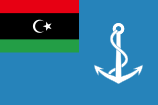
Back Vlag van Libië Afrikaans የሊቢያ ሰንደቅ ዓላማ Amharic علم ليبيا Arabic علم ليبيا ARZ Bandera de Libia AST Liviya bayrağı Azerbaijani Сцяг Лівіі Byelorussian Сьцяг Лібіі BE-X-OLD Национално знаме на Либия Bulgarian লিবিয়ার ফিরালহান BPY
 | |
| Use | National flag, civil and state ensign |
|---|---|
| Proportion | 1:2 |
| Adopted | 24 December 1951 3 August 2011 (re-adoption) |
| Relinquished | 1 September 1969 |
| Design | A horizontal triband of red, black (double width) and green; charged with a white crescent and five-pointed star centred on the black stripe. |
| Designed by | Omar Faiek Shennib |
 | |
| Use | Naval ensign |
| Design | A cerulean ensign with the Libyan Flag in the canton, and a white anchor in the fly side. |
The national flag of Libya (Arabic: علم ليبيا ,Ealam Libia) was originally introduced in 1951, following the creation of the Kingdom of Libya. It was designed by Omar Faiek Shennib and approved by King Idris Al Senussi who comprised the UN delegation representing the three regions of Cyrenaica, Fezzan, and Tripolitania at UN unification discussions.
The flag was abolished following the fall of the Kingdom in 1969, and the dictator Muammar al-Gaddafi had implemented a few other different flags since then, but it was ultimately readapted by the National Transitional Council following the fall of Gaddafi on 3 August 2011.
The flag consists of a triband red-black-green design, the central black band being twice the width of the outer bands. A white star and crescent[1] is located in the center of the flag.
- ^ "Is the Crescent Moon a Symbol of Islam as Is Widely Believed?". Learn Religions. Retrieved 18 January 2022.
© MMXXIII Rich X Search. We shall prevail. All rights reserved. Rich X Search